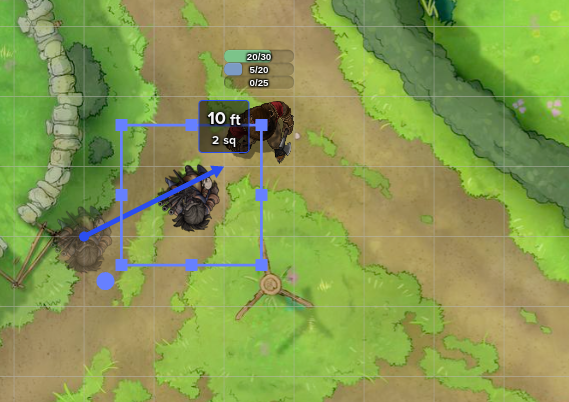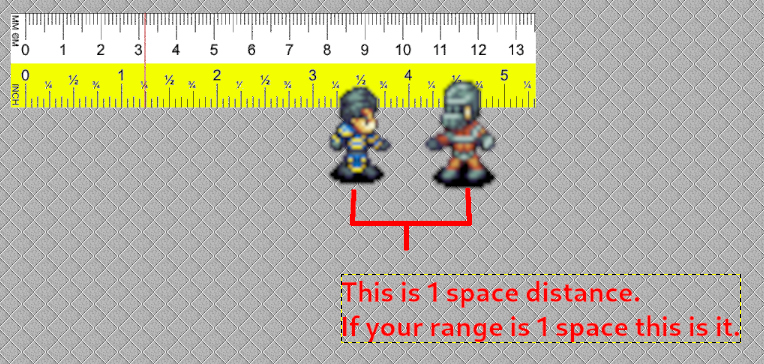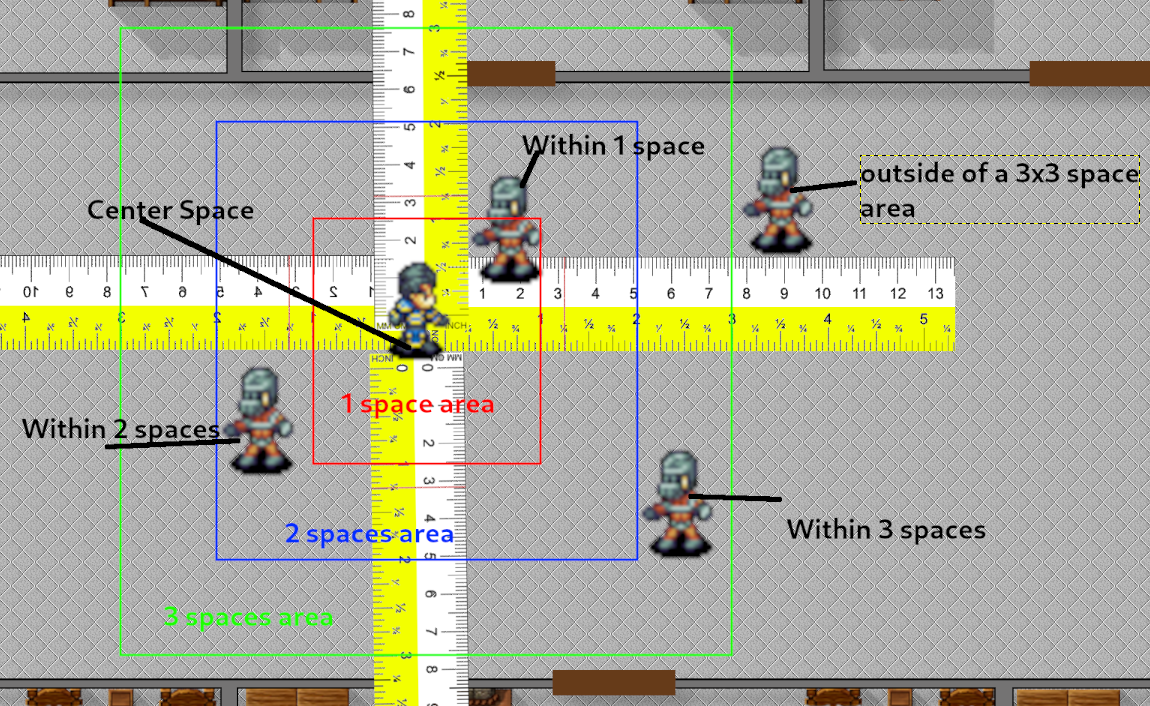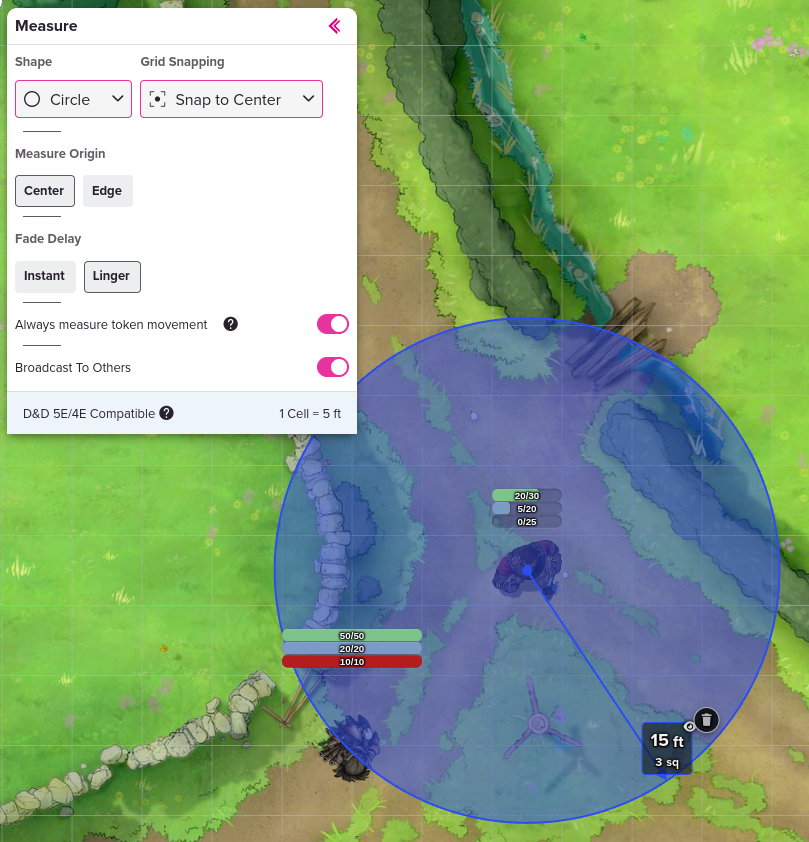The Active Turn is when you can act. This is portion of the round when you can move, attack, use skills, spells, and items. The active round lasts until you have completed your movements.
Back to top1) Actions
While in the Active Turn, you make make use of the following combat actions: Attack, Support, Move, and Magic. You only get to do one of each per active turn in combat. That means, you get to attack once, do one supportive action like drink a potion or reload, move once, and use or start casting one magic spell.
During your active turn, you can do the following:
- Attack: You can attack once. This attack can be a simple attack or an offensive skill. This could be a simple attack with no skill use, or it could be using a skill. Once you have performed an attack action, you cannot attack again that round.
- Move: You can move once during your active turn. The distance you can move is based on your character's move rate. Once you have moved, you cannot move again that round. If you have not used all of your move rate and have stopped to attack, you still cannot move to complete your move rate. Simply getting up if you have fallen or been knocked down counts as a move, as does turning without moving. Once you have stopped moving your move action is done for that round.
- Support: You can make one support action per turn. This might be to use a potion, change equipment, or use a supportive skill. Once you have performed a support action, you cannot perform another one that round.
- Magic: You can cast one spell per turn. If you wish to cast a spell that takes longer than your character can cast in a round do to casting speed, you start the spell but do not perform it until the required casting speed has been reached. Basically, if you wish to use a spell that takes 2 casting speed to cast, but you only have a runic casting speed of 1, it will take you two rounds to do said spell, whereas if you had a runic speed of 2 you can perform that spell immediately.
You may choose to wait until the end of the round to act or wait until a person with a slower initiative than you. However once you choose to act, any actions you do not preform are wasted.
Back to top2) The Ruler
3) Attacking
Attacking is simply the act of attacking an enemy target with your weapon. You need to be within range and declare that you are attacking the enemy target and roll your Hit Chance. If the physical hit is greater than the target's Physical Armor, they you declare the damage that you will do to the target. It will be up to the target to defend. This is your attack action, and you cannot preform another one until the next round.
The damage you do is depending upon the weapon you use. For example, if you are using a hand-held weapon, you would add your offensive power to your weapon’s damage value and that would be the total damage you will deal to your enemy target. If it is a bow and arrow then you would add bow power to the weapon’s combined damage value (bow damage value plus arrow damage value) to determine how much damage you are going to do to the enemy target. If it is a thrown weapon, you add your offensive power to the weapon’s damage value and that would be the total damage. For other kinds of weapons such as guns and crossbows, you would simply give their damage values because you would not have any strength based damage value to add to the weapon’s damage value.
- Offensive Power: This is used with any hand-held weapons. It is also used if you are punching, kicking, head butting, or any attack using your full strength. This is also added to thrown attacks.
- Bow Power: This is used when you use a bow and arrow.
- Crossbows or Guns do not use strength therefore they use none of these.
There are also dual wielding and two-handed weapons which can give you a bonus to your attack.
- Dual Wielding: You are using two weapons at the same time with one attack. You need to have the dual wielding ability for the weapons you wish to dual wield to do this.
- 2-Handed Weapons: Wielding a 2-Handed weapon allows you to apply Offensive Power twice. Therefore your attack would be Offensive Power + Offensive Power + Weapon Damage.
Finally there's hand dominance. If you are right handed but attack with your left hand, you only get to add 1/2 your offensive power. Bow's must be used with your dominate hand so they never have this penalty. You might use your weaker hand if your dominate hand is being restrained or is injured. You cannot dual wield without the dual wielding skill.
That is the very basics of attacking.
3.1) Aided Attacks
You can also make use of what is called an Aided Attack. An Aided Attack is when you are sacrificing your attack action to attack at the same time with your ally. There are certain rules that come in to play here…
- You must be in range of the target your ally is attacking. This can be melee, throw, or projectile range.
- You can perform a skill.
- You must not have went yet.
- Doing so takes away your ability to attack when it comes your turn, however you can still perform other actions.
- Your attack is performed as if it was your action, and is added to your ally's attack, increasing your ally's attack total.
- You must make your hit chance.
If your ally is performing an attack skill chain that lets him or her perform multiple attacks, yet you are performing only one, your attack is added to his first attack. If you are performing the same multi-attack skill as your ally, each attack of yours is added to his or her attacks.
The best way at looking at this is that you are increasing the damage your ally does by attacking with your ally. This could prove quite usefull if you are trying to deal massive damage in a single attack . If you are a weaker character, you may find it more advantageous to aid your stronger ally in his or her attack instead of attacking by yourself, because then more of the damage you add to the attack might make a difference in the outcome of the battle.
3.2) Criticals
There are three types of criticals: critical success, critical failure, and critical hits.
Critical Success: Critical Success applies when using a skill or a spell and you roll a 20. Critical Successes double the point value effect of the skill or spell and doubles offensive or bow power.
Critical Failure: Critical Failure applies when using a skill or a spell and you roll a 01. You uterly and completely failed at what you were doing. If the skill or spell is an offensive or healing skill or spell, it could potentially do something. To determine this, roll a 1d6.
- Rolling a 1: If you roll a 1 on the 1d6 roll, you somehow still manage to preform the skill or spell as intended. This is considered a lucky break because despite how badly you failed, it still worked.
- Rolling a 6: Rolling a 6 on a 1d6 is the worst possible fail. Typically this means that the skill or spell did opposite of what you intended. Maybe you meant to heal your friend with Essence Bolt, but instead you injured your friend more. Maybe you tried to cast Earthen Angers at an enemy but instead cast it at an ally or yourself. Maybe you tried to do a 2-Hit Combo, but you failed so bad you hurt yourself in the process. Obviously the effects can vary with the situation and depend upon the GM to decide what happens here.
- Rolling a 2 - 5: Any roll besides a 1 or a 6 is simply a fail.
Obviously situations, what you were doing, weather, environment, and the like can have a play in what happens during a critical success or fail. The GM may reward you for your creativity even if you rolled a 1.
Critical Hits: A critical hit is where you do more than normal damage against a target. You would refer to either your character's Critical trait. Simply make a critical check with your attack, the difficulty would depend upon how hard it would be to make a critical hit on that target. In most cases, it would be a normal critical check. If you succeed, the damage your character dealt is increased by doubling the appropriate attack power (offensive or bow power).
Critical Hit Example
If you attack a target and succeed critical check, you will deal an extra offensive power worth of damage. If your offensive power is 2 + 1d6, this means you will be doing 4 + 2d6 offensive power damage. If you roll a 20 on your critical check you will add double your offensive power to your offensive power for that attack, so 6 + 3d6 in this example. You will also get a chance for a 1d6 roll for an instant kill of the target, with 6 = instant kill.
3.3) Melee Attacking
Melee attacking is any form of attack in which you hit a target physically, but didn't do so by throwing something at the target or shooting the target. This can be done so by attacking with your hands, feet, or any weapon you hold in your hands.
Melee attacks will always add your character's Offensive Power to the damage. If you are unarmed, this is really the only damage you will do to the target, unless you use a skill of course. If you are armed, this is as simple as:
Offensive Power + Weapon Attack Value = Damage Dealt
When using a melee attack, the offensive power will always be the first value in your attack.
If you use a skill when you do a melee attack it would be:
Offensive Power + Weapon Attack Value + Skill Attack Value
If the skill also increased your melee power you'd add that value to your melee power for the attack.
If you succeed at your critical check, you would add Offensive Power in again:
Offensive Power + Offensive Power + Weapon Attack Value + Skill Attack Value
3.4) Throwing Attacks
Throwing attacks is when you attack a target by throwing something at that target. The method of attacking is the same as melee attacking.
Offensive Power + Weapon Attack Value + Skill Attack Value
If you succeed at your critical check you would add Offensive Power in again:
Offensive Power + Offensive Power + Weapon Attack Value + Skill Attack Value
3.5) Projectile Attack with Bow & Arrow
This is where you shoot a projectile at your target using a bow. The method of attacking is the same as melee attacking, except you would use bow power instead of offensive power. You would also have two weapon attack values instead of one.
Bow Power + Bow Attack Value + Arrow Attack Value + Skill Attack Value
If you succeed at your critical check, you would add Bow Power in again:
Bow Power + Bow Power + Bow Attack Value + Arrow Attack Value + Skill Attack Value
3.6) Guns & Crossbows
Guns and Crossbows, and other similar weapons, do not rely on the wielder's strength. Therefore, you do not get to add any melee, bow, or throw power into the attack. Instead, it will be two weapon damages.
Gun or Crossbow Attack Value + Ammo Attack Value + Skill Attack Value
However, if you make a successful luck check, you can make a critical hit with these weapons too. Doing so allows you to use the projectile weapon's attack value (gun or crossbow for example) twice.
Gun or Crossbow Attack Value + Gun or Crossbow Attack Value + Ammo Attack Value + Skill Attack Value
3.7) Critical Critical Hits
Rolling a 20 in the ultimate critical success. For skills and spells this typically means that the effect is doubled. However, rolling a 20 for a critical hit can mean even more.
- Deathblow Chance: A 20 on a critical hit gives you the chance of instantly killing the target. You would roll a 1d6. If a 6 is rolled, that target is instantly killed by your hit. Even if the target is fully defending and blocking, this hit will kill the target.
- Epic Casting: if the 20 critical hit is with a spell, it would either instantly kill or fully restore the target - depending on if the spell is damaging or healing. You would roll a 1d6. If a 6 is rolled, the target is instantly killed or restored fully. This spell will kill the target, even if the target is immune or has 100% magic protection against that element.
- Double Crit: If a 6 isn't rolled, the hit is considered a double crit. In this instance, you will add your offensive, bow, or runic power twice. With a normal crit, you are only adding it once. For example, with a double crit melee attack:
Offensive Power + Offensive Power + Offensive Power + Weapon Attack Value + Skill Attack Value
3.8) Critical Failure of a Critical Hit
This is when you roll a 01 when attempting to do a critical hit. If it is just a check for the critical hit bonus, rolling this means you do no damage at all. If it is a skill being used or spell being cast, then the rules for critical mishaps will apply instead.
Back to top4) Facing Direction
When you attack you can only attack to your front, unless you are using a skill that states otherwise. Therefore you will need to have some way of identifying the front of your character’s identifier on the battle map. Not only can you attack only to your front, but also if you attack another target to their back sides or out of their view range that lessens their ability to defend against your attack. The following illustration should help you understand the different sides of a character as seen on a battle map.
Facing Direction Example
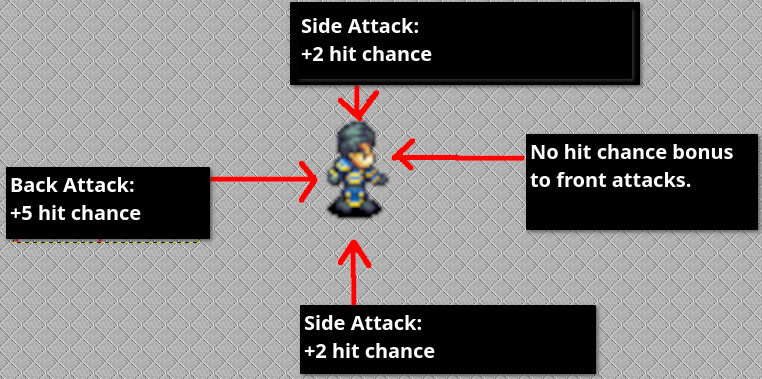 | 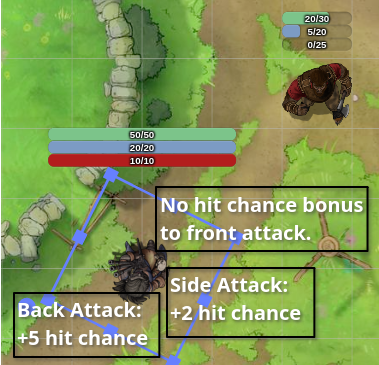 |
| Above is if you are playing this in person at a table. | Above is if you are playing the game using roll20. |
Above is an example showing the direction that you are facing. If a target hits to the front of you you can see the attack and react, giving the target no bonuses to their hit chance. If the target attacks to the side of you, the target gets a +2 to their hit chance because it is harder for you to react. If the target attacks you from behind, the target gets a +5 to their hit chances due to how difficult it would be for your to react. You get those same bonuses as well.
5) Dealing With Hidden and Covered Targets
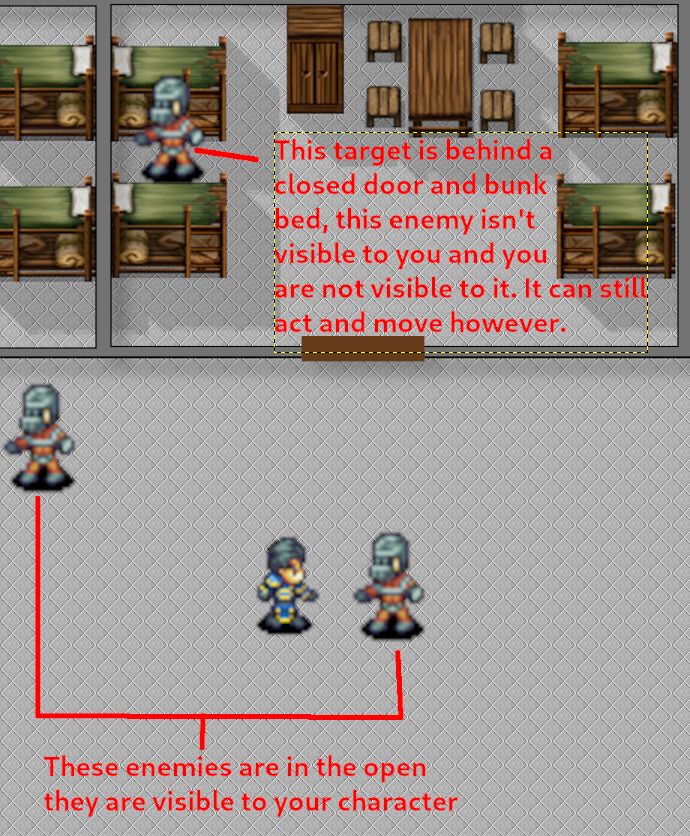 | 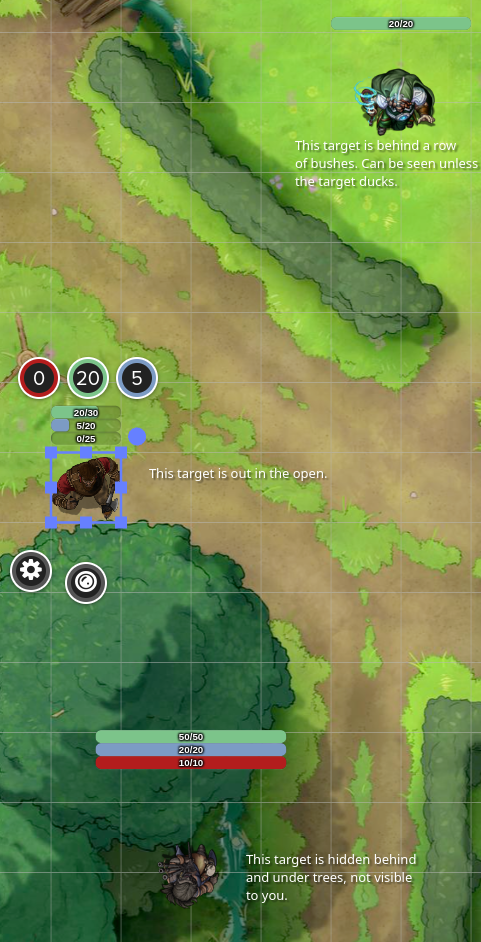 |
| Above is if you are playing this in person at a table. | Above is if you are playing the game using roll20. |
If you cannot see an enemy, you cannot attack that enemy - unless of course you are using Blind Shot. Instead, you must first make a perceive check to spot the enemy that is hiding, applying any difficulties and penalties that may exist, which the GM will tell you about.
If the enemy is hidden behind an obstacle, the enemy is considered covered. You would first have to be on the same side of the obstacle as the enemy is. If the enemy is also hiding you will need to then make your perceive checks. You simply cannot hit an enemy beyond or through an obstacle unless you are using an area of effect skill or spell that goes beyond the obstacle, which is up to GM discretion.
6) Using Skills and Spells
Using Skills and Spells is another action you can make during the active round. For the most part, this is pretty straight forward. You simply use the skill or spell by making the success roll check, and the describe what the skill or spell does. Some skills or spells will do damage, some will cause status effects, some will heal, and some will benefit you or your allies. You will need to spend the action costs and stat point costs, whether you are successful or not at using the skill or spell, and yes you can use minor elemental manipulations.
Perhaps the most confusing aspect of a spell or skill is the skill's area’s of effect. If a skill lists its area of effect as one by one (1 x 1) space around the user, you would count out 1 inch on a ruler, all around your identifier, and the skill or spell would only affect those in the radius of the skill or spell.
Remember, we use a ruler. 1 inch is 1 space.
1 Space Example
Most melee attacks including unarmed attacks require you to be within 1 space of your target. Some weapons though may have greater range allowing for more space to be between you and your target.
Area of Effect Example
It should be noted that any area that is blocked by walls might be outside of the area of effect even if it is technically within the area of effect. This is especially true of the spell requires you to see the target.
Targets that are within the area of effect are affectd by the area of effect spell. Targets outside of the area of effect are not. For example if the spell is 3x3 spaces area of effect, the target outside of the 3x3 area is not effected.
Back to top7) Magic
Like Attacking, you can only cast one magic spell once per turn, unless of course you have a skill such as Quick Magic. Once you have cast a spell, or attempted to, your magic action is considered completed. Magic skills can be used with casting spells however, as long as they add to or affect in some way the spell you are wishing to cast.
7.1) Aided Magic
You can also make use of what is called an Aided Magic. An Aided Magic is when you are sacrificing your magic action to cast a spell at the same time with your ally. There are certain rules that come in to play here…
- You must be in range of the target your ally is targeting.
- You can not add magic skills to this, unless they state that they are used during the casting of a spell.
- You must not have went yet.
- Doing so takes away your ability to cast spells when it comes your turn, however you can still perform other actions.
- Your spell is performed as if it was your action, and is added to your ally's spell, increasing your ally's spell total.
- You must make your hit chance.
- You and your ally cannot be of opposing elements.
- The spell type must be the same type, such as healing or damaging
8) Movement
Another activity you can take part in during your active round is movement. For the most part, movement is rather simple. You can move once during your active round. The distance you can move is based on your character's battle movement rate. Once you have moved, you cannot move again that round. If you have not used all of your movement rate and have stopped to attack, you still cannot move to complete your movement rate. Once you have stopped moving your movement action is done for that round.
Simple yes? You simply move your character's battle movement rate to the location on the battle map you want to go. But there are a few special situations that you should know about.
8.1) Sprinting
Typically, you can only move your character's battle movement rate during your character's active round. But what if you need to get somewhere in a hurry? You can sprint. Sprinting is a short run which allows your character to travel farther than he or she normally would during your active round. Every character can sprint. You simply need to spend the energy to do so. Sprinting allows you to move at double your character's move rate at a cost of 2 Power per use.
8.2) Crawling
Imagine, if you will, a battlefield with obstacles that you can duck behind to hide from those pesky silver imps and their deadly accurate crossbows. Now what if you wanted to try to move while remaining low enough to still be covered by the obstacle? You can do so by crawling. Crawling allows you to move at half your move rate while remaining low to the ground.
8.3) Flying
Some races are blessed with the ability of flight and some spells also grant this ability. Flying is incredibly useful as in most cases it allows you to move across the battlefield at three times your move rate spending only a small amount of Power. However, flying might not always be possible in every battle. Before you try to fly, you need to make sure with the GM that the environment will allow your character to fly. In order to make use of the flying movement bonus, your character must be able to fly over most obstacles. However, if your character can't fly, that doesn't mean that you can't make use of your wings to aide in movement. Maybe you can also glide, or at least use your wings to give a small movement bonus? Check with your GM, surely he or she will be able to work with you to help make the best use of your character's unique ability.
8.4) Obstacles
Battlefields are rarely empty, sparse plains. Oftentimes they are filled with all kinds of obstacles such as water, debris, stairs, pit holes, trees, and so forth. Sometimes you may need to climb to deal with the obstacle. Other times you may need to swim. Finally, some obstacles cannot be surpassed. When dealing with obstacles that require climbing or swimming, refer to the rules for such in the general gameplay rules section.
8.5) Triggering "Attack of Opportunity"
If you move you have a chance to trigger what is called an Attack of Opportunity. This is a chance for the target to attack you to prevent you from moving. You of course get the same chances should your target move. An Attack of Opportunity can be triggered if the following happens:
- The target you attacked (or you) tries to move away from you.
- A target (or you) moves within or across the range of you (or the target) and said target was facing you (or you facing target). This can include jumping and flying.
If an Attack of Opportunity happens you get to make a hit chance. If you succeed, you attack the target and the target has to stop right where you attacked the target. The target's move is then ended and the target must spend the rest of his or her active turn in that space. You can perform skills in your attack, but not spells due to the fact that the attack is sudden.
Back to top9) Support Actions
Support Actions is another type of activity that you can make during your active round. You can make one support movement per round. This might be to use a potion, change equipment, or use a support skill. Support skills will cost support actions. Once you have performed a support action, you cannot perform another one that round.
As far as using items is concerned, a support action covers both getting the potion and drinking the potion, all in one action.
If you are wanting to use a potion on an ally, you need to be one space away from that ally and facing that ally. If you are farther away, you will need to either move or to throw using your attack action. If you throw a potion, every target in the path or next to the path of the thrown item can make a free react check to catch the item, including the intended target. The first person in the path to catch the item gets the item. If no one succeeds to catch the item, it is considered a wasted item.
It also is considered a support action to change your equipment. You can change as much equipment as you want during that support action but once you stop you cannot chance any more equipment until the next round.
You do need to use support actions to reload your projectile weapons unless the projectile weapon declares that you do not.
- 1 support use for reloading
- 1 support use for changing weapons or gear
- 1 support use for taking or using potions
- 1 support use for a support-type skill

